
| Home page Installations Exhibiitions Editions Projects Invitations Biography Texts Links ContactFor a Landscape of Water Publics Benches The Fallen Tree Collateral Gains At the end ot the tunnel / Grotesque / Documentary The Sand Quarry in the Mangrove Swamp The Landing Place Dialogue on Rainy Days The Carter The Foutain The Waste land Carbolux The Camp of l'Ermitage The Barque Long-viiew-la-Masure 14 Benches face à face Balance The Home of Alders + Bruni/Babarit's website |
A shelter in the hermitage: build, live, experiment, exchange (in search of the hermit) French artist Gilles Bruni produces contextual based landscape works. He is particularly interested in the ecology of a place, its inhabitants and their history. He often, therefore, builds collaborations and partnerships with others to make work happen. His art works and field activities have taken him beyond France to Germany, the USA, Canada, Denmark, Italy, Austria and Venezuela. We are delighted that this residency will be his first in the UK. At Hestercombe he is drawn to the Landscape Garden and the potential restoration of an eighteenth century ‘Hermitage’. From 9th July he will become Hestercombe’s own ‘Hermit’; building a shelter and reacting with visitors. Not only does this work relate to the history of Hestercombe but for the artist it also resonates with today’s migrant crisis. Context Situation: at the Hermitage site, on the sidelines of the Georgian Landscape. Dates: July 9rd-22th Materials: laurel branches, strings, logs, various effects of the camp (books, bags, dishes, grill, charcoal, stove, bottles of water ...) Size of the shelter: ovoid form around 4 m length by 2 m width. Height around 2,5 m. Collaboration: Dan McCarthy and Clément Bruni. Commentary Gilles Bruni – The Hermitage, Hestercombe The Hermit… Gilles was fortunate to discover an abundance of newly felled laurel branches just a few metres from the site of his proposed hermit’s hut. The site lay just off a path than rose from the pear pond at Hestercombe. It had the remains of a brick and slate building that may have actually been constructed as an ornamental hermitage in the 18th Century landscape garden, and this spot has continued to be referred to as the Hermitage, whether this appellation was accurate or not. All the elements required for Hestercombe’s new hermitage were present – the site, the materials and, perhaps most important, the hermit, albeit the last was only planning to stay for two weeks… An early visit with Gilles revealed his appreciation of the layers of history left here by the passage of people. The outlines of the brick walls and foundations of the 18th century structure were sat among scattered rubble and shallow trenches. Black plastic bags adorned the site and the remains of an impromptu fire lay half hidden among the bracken. An empty cider can gave mute testimony to recent occupation. Gilles became interested in reclaiming this space, this Hermitage. His construction of a shelter would be both a practical activity and an artistic endeavour – Gilles is after all a landscape artist. Using materials obtained from his immediate environment he would craft an eco-hermitage and then spend time within and around it. Looking out across the vale of Taunton to the distant Blackdown hills through his roughly made window, allowing the peace and serenity of the place to calm his thoughts and quieten his mind. That at least was the plan. And so. under the cloudless skies in the middle of June’s heat wave, Gilles cut, shaped, tied and wove his treasure of laurel. The shelter’s footprint was informed by where it sat – on a slightly elongated oval clearing to the front and right of the original hermitage’s footings, more central to the site and perfectly placed on a slight rise above the main path. Its form derived from the necessity to have doorways adjacent to the two small paths that traversed the site, to be high enough to stand within and to be long enough to allow a person to stretch out, to sleep perhaps, under shade. It began as a skeletal frame but grew quickly with Gilles’s intuitive understanding of how the branches wanted to align. From bare bones the structure grew and filled. Gilles’s son Clément arrived from France to join in the construction work. The building process moved quickly. Soon a version of the final form emerged. It echoed primitive shelters from across the globe - its shape hinted at the tipis of the Native American Dakota people, its branch and interlocking pole construction resembled the wickiups built by the Paiute of Colorado – clearly when faced with similar needs for shelter, and working in harmony with similar materials, Gilles was arriving at similar conclusions. Wickiups rarely had to protect against rain however, so Gilles carefully laid a plastic sheet into his roof… While the construction of the shelter was in progress, over a period of around a week, occasional visitors would appear. At this point the path to the Hermitage was closed, albeit by a simple rope drawn across the head of the path by the Turkish tent and another at the lower extremity by the Pear Pond. Nonetheless adventurous individuals were finding Gilles and Clément at various times of the day choosing pieces of timber from the woodpile, dressing branches and dragging them to the site, working them into the structure, knotting rope. Most visitors were eager to engage in conversation, surprised perhaps by the presence of Gilles and his son embarked upon a work of such strangeness. At these times the work of construction would cease, and the work of explaining the project would begin. Gilles always understood that the Hermitage project would have a contradiction at its very core – a contradiction that required him not least to construct the new hermitage and reside within it and spend some portion of that time in contemplation, but also to act as the “new hermit” of Hestercombe, engage the public, inform and entertain them. These two, seemingly incompatible, requirements began to exert strong, diametrically opposed pulls upon Gilles, and throughout his second week, a week when construction was complete and the hermitage was open to the public, Gilles found himself increasingly required to switch from quietness, isolation and solitude to become the genial artist in residence, smiling and welcoming the curious guests into his “private” space, answering questions, explaining his purpose here... Gilles was, of course, completely assured and professional with his visitors. They delighted in this charismatic Frenchman living en plein air in the landscape garden, reinterpreting the role of hermit. Many exhibited great knowledge of English ornamental hermits and hermitages and sought to broaden Gilles’s understanding of this uniquely British phenomenon. Gilles became aware gradually of the entirely secular nature of the ornamental hermit during this time, the possibility that if a hermitage did exist on the Hestercombe site, it would not have been inhabited by someone pursuing religious enlightenment. From contemporary accounts, the 18th century hermit would have been a simulacrum, likely an indigent local, who would be dressed in camel hair and given props – a bible and an hourglass perhaps – and installed in the hermitage that he might encourage the estate’s well-to-do visitors to contemplate mortality, or more likely to remark how witty and wealthy was their host, to entertain them so. An actor, albeit a resident one with only one part to play. The possibility of such disingenuity at the core of the 18th century hermitage seemed to trouble Gilles, believing, as he had, that these hermits were possibly religious men given sanctuary by the estate to pursue their lives of piety and meditation, albeit whilst on display. I believe Gilles’s disquiet may also have been exacerbated by the exquisite beauty of his surroundings. On quiet days Gilles would sit under blue skies watching the sun move left to right across the tall oaks and birches around him. His companions were the buzzards perched in the dead tree a scarce twenty metres from his door, the inquisitive robin who showed no fear of the quiet bearded inhabitant of the laurel house or the many and varied insects who walked, hopped and flew through his open doors. Gilles embraced the opportunity to withdraw from the world and inhabit a smaller, quieter place. He was daily travelling further into this space, and like a person waking from deep sleep, being required to suddenly deal with curious inquisitive intruders was becoming increasingly dislocative. But there were deeper currents at work, and other themes were emerging. Possibly in part due to the weakening of the power of the narrative of the hermit, and perhaps in part to the experience of seeing himself alone, in a rough shelter with his scant possessions surrounding him and often invisible to passers by, Gilles began to see the parallels between his experience and that of society’s other “new hermits” - the homeless, the dispossessed, migrants, refugees, the marginal people who live, unseen and unloved on the edges of society. He had told me a story some weeks previously. I only realised its potency after Gilles had left. When in Nova Scotia, Canada in 2016 Gilles had stumbled upon a deserted camp hidden almost in plain sight among undergrowth adjacent to a built-up area. He described a tent, left open, within which all the detritus of a life abandoned lay bare. Sleeping bag, a scattering of clothing, some few toiletries. Things that surely would not have been left unless circumstances were so pressing that there was no time for an orderly exit. Gilles pondered this unfinished narrative – who lived here? Why did they make a home here? What has befallen them? It’s clear now Gilles has finished his time at Hestercombe that the mystery of the Canadian camp continued to engage him. His last act as Hestercombe’s hermit was to arrange his hermitage with some mementoes of his time there some scattering of clothing, a cup of coffee, half full, some books lying where they fell, an empty bowl… The landscape, whether urban or rural, abounds with the residue of our fragmentary and fleeting occupation. Nothing is permanent, everything changes, structures fall, people move away. Existence is transitory. We are likely to forget, so preoccupied by our own story, that we were not the first here, we won’t be the last. Look around, see the signs, they are everywhere. Who lived here? Why did they make a home here? What has befallen them? Dan MacCarthy, july 2018, Hestercombe |
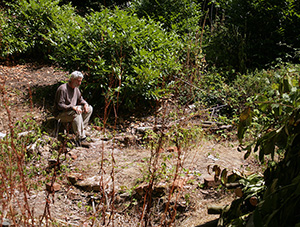 [ + ] 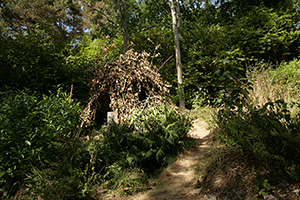 [ + ] 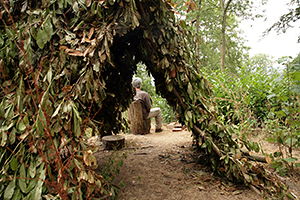 [ + ] 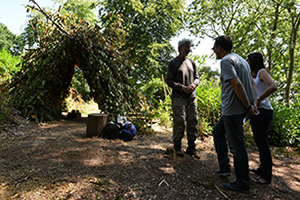 [ + ] 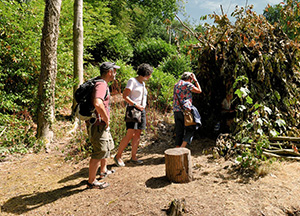 [ + ] | |
